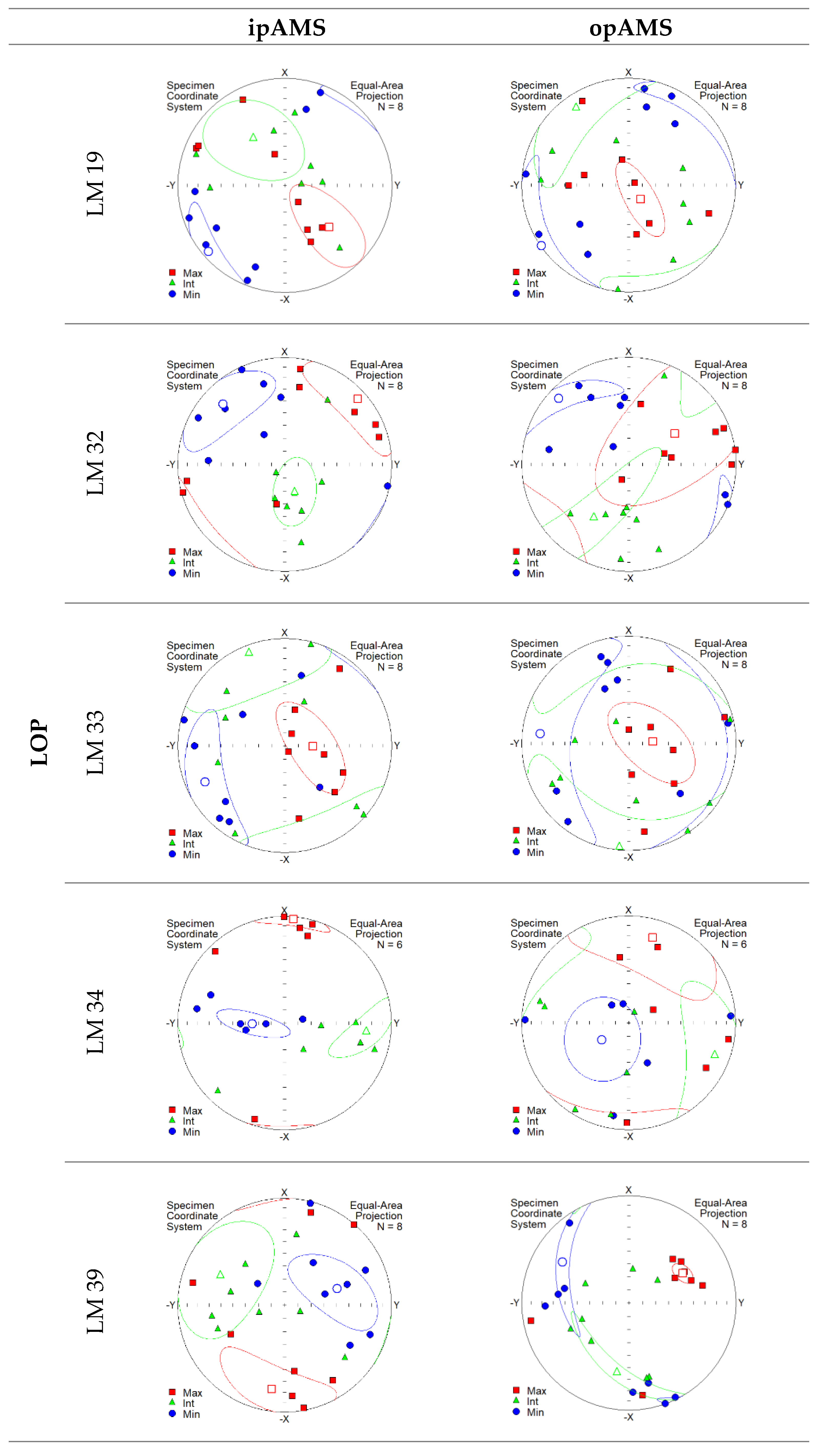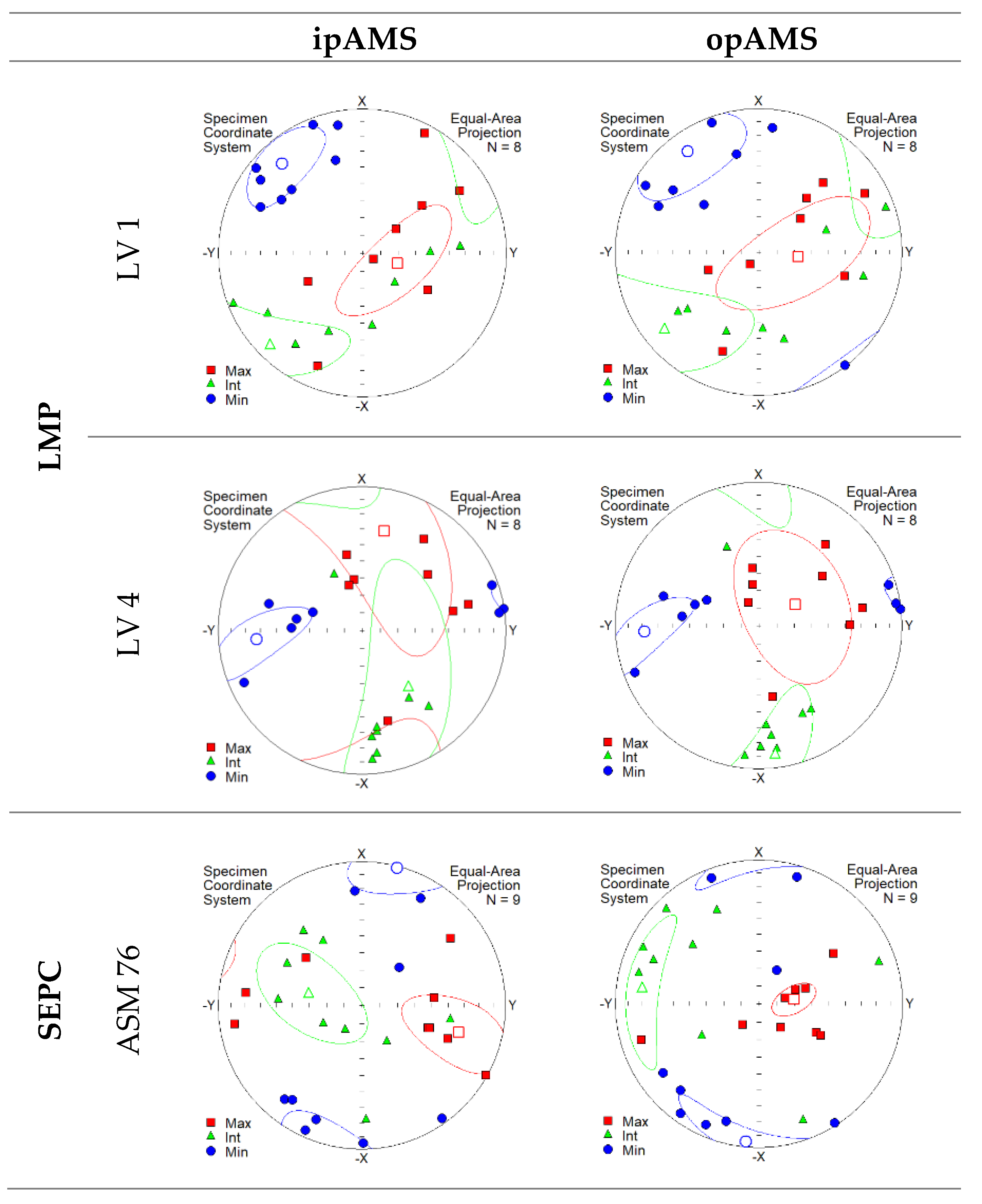Anisotropy of Out-of-Phase Magnetic Susceptibility: A Non-Standard Approach for Magnetic Subfabrics Determination in Variscan Granites of Iberian Massif
Abstract
:1. Introduction
- (i)
- Electrical eddy currents (induced by an AC field in conductive materials) are characteristic of minerals that are at least moderately conductive electrically;
- (ii)
- Weak field hysteresis (non-linear and irreversible dependence of M on H) is typical of minerals that show a wide hysteresis loop, such as titanomagnetite, pyrrhotite, and hematite.
2. Materials and Methods
2.1. Fundamentals of Out-of-Phase Magnetic Susceptibility
2.2. Analytical Techniques and Calculated Parameters
- (i)
- Mean susceptibility (Equation (4)):
- (ii)
- Degree of magnetic anisotropy (Equation (5)):
- (iii)
- Shape ellipsoid (Equation (6)):
3. Geological Setting
3.1. Regional Context
3.2. Studied Plutons
4. Results and Discussion
5. Conclusions
Author Contributions
Funding
Data Availability Statement
Acknowledgments
Conflicts of Interest
References
- Ferré, E.C. Theoretical models of intermediate and inverse AMS fabrics. Geophys. Res. Lett. 2002, 29, 1127. [Google Scholar] [CrossRef]
- Hrouda, F.; Jelinek, V. Resolution of ferromagnetic and paramagnetic anisotropies, using combined low-field and high-field measurements. Geophys. J. Int. 1990, 103, 75–84. [Google Scholar] [CrossRef] [Green Version]
- Rochette, P. Magnetic susceptibility of the rock matrix related to magnetic fabric studies. J. Struct. Geol. 1987, 9, 1015–1020. [Google Scholar] [CrossRef]
- Martín-Hernandez, F.; Hirt, A.M. A method for the separation of paramagnetic, ferrimagnetic and haematite magnetic subfabrics using high-field torque magnetometry. Geophys. J. Int. 2004, 157, 117–127. [Google Scholar] [CrossRef] [Green Version]
- Ferré, E.C.; Martín-Hernández, F.; Teyssier, C.; Jackson, M. Paramagnetic and ferromagnetic anisotropy of magnetic susceptibility in migmatites: Measurements in high and low fields and kinematic implications. Geophys. J. Int. 2004, 157, 1119–1129. [Google Scholar] [CrossRef] [Green Version]
- Román-Berdiel, T.; Casas, A.M.; Oliva-Urcia, B.; Pueyo, E.L.; Liesa, C.; Soto, R. The Variscan Millares granite (central Pyrenees): Pluton emplacement in a T fracture of a dextral shear zone. Geodin. Acta 2006, 19, 197–211. [Google Scholar] [CrossRef]
- Raposo, M.I.B.; Gastal, M.C.P. Emplacement mechanism of the main granite pluton of the Lavras do Sul intrusive complex, South Brazil, determined by magnetic anisotropies. Tectonophysics 2009, 466, 18–31. [Google Scholar] [CrossRef]
- Oliva-Urcia, B.; Larrasoaña, J.C.; Pueyo, E.L.; Gil, A.; Mata, P.; Parés, J.M.; Schleicher, A.M.; Pueyo, O. Disentangling magnetic subfabrics and their link to deformation processes in cleaved sedimentary rocks from the Internal Sierras (west central Pyrenees, Spain). J. Struct. Geol. 2009, 31, 163–176. [Google Scholar] [CrossRef]
- Martín-Hernández, F.; Ferré, E.C. Separation of paramagnetic and ferrimagnetic anisotropies: A review. J. Geophys. Res. 2007, 112, B03105. [Google Scholar] [CrossRef] [Green Version]
- Hrouda, F.; Pokorný, J.; Jezek, J.; Chadima, M. Out-of-phase magnetic susceptibility of rocks and soils: A rapid tool for magnetic granulometry. Geophys. J. Int. 2013, 194, 170–181. [Google Scholar] [CrossRef]
- Hrouda, F.; Chadima, M.; Jezek, J.; Pokorný, J. Anisotropy of out-of-phase magnetic susceptibility of rocks as a tool for direct determination of magnetic subfabrics of some minerals: An introductory study. Geophys. J. Int. 2017, 208, 385–402. [Google Scholar] [CrossRef]
- Hrouda, F.; Chadima, M.; Ježek, J.; Kadlec, J. Anisotropies of in-phase, out-of-phase, and frequency-dependent susceptibilities in three loess/palaeosol profiles in the Czech Republic; methodological implications. Stud. Geophys. Geod. 2018, 62, 272–290. [Google Scholar] [CrossRef]
- Hrouda, F.; Chadima, M.; Ježek, J. Anisotropy of Out-of-Phase Magnetic Susceptibility and Its Potential for Rock Fabric Studies: A Review. Geosciences 2022, 12, 234. [Google Scholar] [CrossRef]
- Hrouda, F. Magnetic anisotropy of rocks and its application in geology and geophysics. Geophys. Surv. 1982, 5, 37–82. [Google Scholar] [CrossRef]
- Tarling, D.H.; Hrouda, F. The Magnetic Anisotropy of Rocks; Chapman & Hall: London, UK, 1993; p. 217. [Google Scholar]
- Jackson, M. Imaginary susceptibility, a primer. IRM Q. 2004, 13, 10–11. [Google Scholar]
- Sant’Ovaia, H.; Ribeiro, M.A.; Martins, H.C.B.; Ferrão, F.; Gomes, C.; Noronha, F. Estruturas e fabric magnético no maciço granítico de Lavadores-Madalena. Comun. Geol. 2014, 101, 313–317. [Google Scholar]
- Cruz, C.; Sant’Ovaia, H.; Noronha, F. Magnetic mineralogy of Variscan granites from northern Portugal: An approach to their petrogenesis and metallogenic potential. Geol. Acta 2020, 18, 1–20. [Google Scholar] [CrossRef] [Green Version]
- Dias, J.M.; Cruz, C.; Sant’Ovaia, H.; Noronha, F. Assessing the Magnetic Mineralogy of the Pre-Variscan Manteigas Granodiorite: An Unexpected Case of a Magnetite-Series Granitoid in Portugal. Minerals 2022, 12, 440. [Google Scholar] [CrossRef]
- Sant’Ovaia, H.; Nogueira, P.; Carrilho Lopes, J.; Gomes, C.; Ribeiro, M.A.; Martins, H.C.B.; Dória, A.; Cruz, C.; Lopes, L.; Sardinha, R.; et al. Building up of a nested granite intrusion: Magnetic fabric, gravity modelling and fluid inclusion planes studies in Santa Eulália Plutonic Complex (Ossa Morena Zone, Portugal). Geol. Mag. 2015, 152, 648–667. [Google Scholar] [CrossRef]
- Cruz, C.; Sant’Ovaia, H.; McCarthy, W.; Noronha, F. Anisotropy of out-of-phase magnetic susceptibility: A non-standard approach for magnetic subfabrics determination. In Proceedings of the X CJIG LEG 2020, Estremoz, Portugal, 20–22 November 2020. [Google Scholar]
- Terrinha, P.; Pueyo, E.L.; Aranguren, A.; Kullberg, J.C.; Kullberg, M.C.; Casas-Sainz, A.; Azevedo, M.R. Gravimetric and magnetic fabric study of the Sintra Igneous complex: Laccolith-plug emplacement in the Western Iberian passive margin. Int. J. Earth Sci. 2018, 107, 1807–1833. [Google Scholar] [CrossRef]
- Román-Berdiel, T.; Aranguren, A.; Cuevas, J.; Tubia, J.M. Compressional granite-emplacement model: Structural and magnetic study of the Trives Massif (NW Spain). Lithos 1998, 44, 37–52. [Google Scholar] [CrossRef]
- Pueyo, E.L.; Román-Berdiel, T.; Calvín, P.; Bouchez, J.L.; Beamud, E.; Ayala, C.; Loi, F.; Soto, R.; Clariana, P.; Margalef, A.; et al. Petrophysical Characterization of Non-Magnetic Granites; Density and Magnetic Susceptibility Relationships. Geosciences 2022, 12, 240. [Google Scholar] [CrossRef]
- Ishihara, S. The Magnetite-series and Ilmenite-series Granitic Rocks. Min. Geol. 1977, 27, 292–305. [Google Scholar]
- Chadima, M.; Pokorny, J.; Studynka, J. Safyr7: Kappabridge Control Software (for windows); AGICO, Inc.: Brno, Czech Republic, 2018. [Google Scholar]
- Jelinek, V. Characterization of the magnetic fabric of rocks. Tectonophysics 1981, 79, T63–T67. [Google Scholar] [CrossRef]
- Franke, W. Variscan plate tectonics in Central Europe–current ideas and open questions. Tectonophysics 1989, 169, 221–228. [Google Scholar] [CrossRef]
- Ribeiro, A.; Pereira, E.; Dias, R. Structure in the Northwest of the Iberian Peninsula. In Pre-Mesozoic Geology of Iberia; Dallmeyer, R.D., Martínez Garcia, E., Eds.; Springer: Berlin/Heidelberg, Germany, 1990; pp. 220–236. [Google Scholar]
- Kroner, U.; Romer, R.L. Two plates-Many subduction zones: The Variscan orogeny reconsidered. Gondwana Res. 2013, 24, 298–329. [Google Scholar] [CrossRef]
- Julivert, M.; Fontboté, J.M.; Ribeiro, A.; Conde, L. Mapa tectónico de la península Ibérica y Baleares a escala 1:1,000,000 y memoria explicativa; Instituto Geologico y Mineiro de España: Madrid, Spain, 1974. [Google Scholar]
- Pereira, M.F.; Apraiz, A.; Silva, J.B.; Chichorro, M. Tectonothermal analysis of high-temperature mylonitization in Coimbra-Cordoba shear zone (SW Iberian Massif, Ouguela tectonic unit, Portugal): Evidence of intra-continental transcurrent transport during the amalgamation of Pangea. Tectonophysics 2008, 461, 379–394. [Google Scholar] [CrossRef]
- Pereira, E. Notícia Explicativa da Folha 10-A (Celorico de Basto) da Carta Geológica de Portugal: 1:50 000; Serviços Geológicos de Portugal: Lisboa, Portugal, 1989; p. 53. [Google Scholar]
- Helal, B. Granitoïdes, Granites à Métaux Rares et Hydrothermalisme Associe: Géologie, Minéralogie et Géochimie de Plusieurs Suites Tardi-Hercyniennes (Nord du Portugal). Ph.D. Thesis, Ecole Nacionale Superieure des Mines de Saint-Etienne, Saint-Étienne, France, 1992. [Google Scholar]
- Fernandes, S.; Gomes, M.; Teixeira, R.; Corfu, F. Geochemistry of biotite granites from the Lamas de Olo Pluton, northern Portugal. In Proceedings of the Geophysical Research Abstracts, EGU General Assembly, Vienna, Austria, 7–12 April 2013. [Google Scholar]
- Cruz, C.; Góis, J.; Sant’Ovaia, H.; Noronha, F. Geostatistical approach in the study of the magnetic susceptibility variation: Lamas de Olo Pluton case study. J. Iber. Geol. 2020, 46, 279–289. [Google Scholar] [CrossRef]
- Cruz, C.; Sant’Ovaia, H.; Noronha, F. Magnetic susceptibility and δ18O characterization of Variscan granites related to W-(Mo) and Sn-(W) mineralizations: Lamas de Olo Pluton case study. Comun. Geol. 2016, 103, 143–147. [Google Scholar]
- Martins, H.C.B.; Sant’Ovaia, H.; Abreu, J.; Oliveira, M.; Noronha, F. Emplacement of Lavadores granite (NW Portugal): U/Pb and AMS results. Comptes Rendus Geocience 2011, 343, 387–396. [Google Scholar] [CrossRef]
- Cruz, C.; Roseiro, J.; Martins, H.C.B.; Nogueira, P.; Sant’Ovaia, H. Magmatic sources and emplacement mechanisms of the Santa Eulália Plutonic Complex facies: Integrating geochronological and geochemical data. In Proceedings of the Geoquímica Ibérica: Compendio de los trabajos presentados en el XIII Congreso Nacional de Geoquímica y XIII Congreso Ibérico, Puertollano, Spain, 25–27 April 2022; pp. 223–231. [Google Scholar]





| Pluton | Sampling Site | n | ipAMS | ||||||||||
|---|---|---|---|---|---|---|---|---|---|---|---|---|---|
| Km (×10−3) | Km (×10−6) | Pj | Tj | K1 Dec | K1 Inc | K3 Dec | K3 Inc | E12 | E23 | E31 | |||
| LOP | LM 19 | 8 | 1.77 | 1765 | 1.06 | 0.16 | 133 | 43 | 229 | 6 | 42 | 27 | 10 |
| LM 32 | 8 | 2.02 | 2018 | 1.07 | −0.01 | 48 | 9 | 315 | 20 | 16 | 21 | 36 | |
| LM 33 | 7 | 0.00 | 2 | 1.73 | −0.23 | 103 | 69 | 236 | 15 | 39 | 29 | 12 | |
| LM 34 | 6 | 0.10 | 99 | 1.01 | 0.03 | 5 | 3 | 269 | 65 | 11 | 30 | 7 | |
| LM 39 | 8 | 0.08 | 83 | 1.01 | 0.00 | 189 | 22 | 73 | 47 | 35 | 40 | 19 | |
| LMP | LV 1 | 8 | 16.20 | 16,200 | 1.16 | 0.38 | 106 | 69 | 318 | 18 | 42 | 16 | 17 |
| LV 4 | 8 | 8.41 | 8410 | 1.31 | 0.46 | 12 | 30 | 265 | 27 | 72 | 11 | 29 | |
| SEPC | ASM 076 | 9 | 1.85 | 1851 | 1.07 | 0.08 | 105 | 31 | 14 | 2 | 37 | 20 | 16 |
| Pluton | Sampling Site | opAMS | Phase (°) | ||||||||||
|---|---|---|---|---|---|---|---|---|---|---|---|---|---|
| Km (×10−3) | Km (×10−6) | Pj | Tj | K1 Dec | K1 Inc | K3 Dec | K3 Inc | E12 | E23 | E31 | |||
| LOP | LM 19 | 0.0010 | 0.9501 | 1.59 | 0.27 | 140 | 76 | 235 | 1 | 21 | 53 | 12 | 0.03 |
| LM 32 | 0.0014 | 1.4491 | 2.44 | 0.20 | 56 | 48 | 313 | 11 | 74 | 10 | 37 | 0.04 | |
| LM 33 | 0.0017 | 1.7471 | 1.73 | −0.23 | 105 | 72 | 227 | 10 | 40 | 72 | 13 | 0.06 | |
| LM 34 | 0.0003 | 0.3340 | 1.36 | −0.15 | 16 | 18 | 238 | 66 | 53 | 23 | 32 | 0.19 | |
| LM 39 | 0.0011 | 1.1353 | 1.40 | 0.03 | 61 | 42 | 302 | 28 | 6 | 54 | 6 | 0.79 | |
| LMP | LV 1 | 0.0481 | 48.0875 | 2.77 | 0.29 | 96 | 68 | 325 | 15 | 51 | 23 | 22 | 0.17 |
| LV 4 | 0.0085 | 8.4950 | 5.24 | 0.50 | 60 | 66 | 267 | 22 | 45 | 31 | 10 | 0.06 | |
| SEPC | ASM 076 | 0.0001 | 0.1157 | 30.73 | 0.24 | 83 | 70 | 186 | 5 | 11 | 37 | 7 | 0.01 |
Publisher’s Note: MDPI stays neutral with regard to jurisdictional claims in published maps and institutional affiliations. |
© 2022 by the authors. Licensee MDPI, Basel, Switzerland. This article is an open access article distributed under the terms and conditions of the Creative Commons Attribution (CC BY) license (https://creativecommons.org/licenses/by/4.0/).
Share and Cite
Cruz, C.; Sant’Ovaia, H.; McCarthy, W.; Noronha, F. Anisotropy of Out-of-Phase Magnetic Susceptibility: A Non-Standard Approach for Magnetic Subfabrics Determination in Variscan Granites of Iberian Massif. Minerals 2022, 12, 1376. https://doi.org/10.3390/min12111376
Cruz C, Sant’Ovaia H, McCarthy W, Noronha F. Anisotropy of Out-of-Phase Magnetic Susceptibility: A Non-Standard Approach for Magnetic Subfabrics Determination in Variscan Granites of Iberian Massif. Minerals. 2022; 12(11):1376. https://doi.org/10.3390/min12111376
Chicago/Turabian StyleCruz, Cláudia, Helena Sant’Ovaia, William McCarthy, and Fernando Noronha. 2022. "Anisotropy of Out-of-Phase Magnetic Susceptibility: A Non-Standard Approach for Magnetic Subfabrics Determination in Variscan Granites of Iberian Massif" Minerals 12, no. 11: 1376. https://doi.org/10.3390/min12111376






